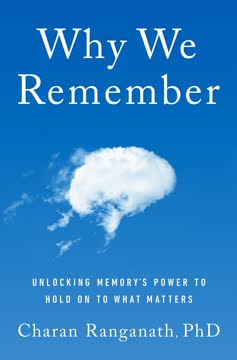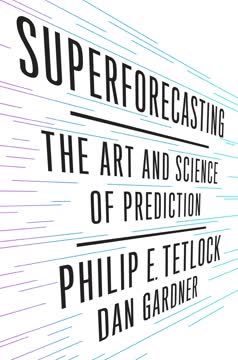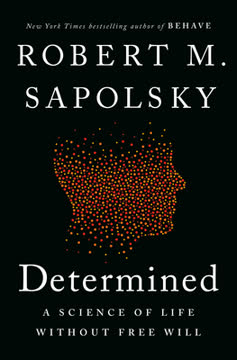Key Takeaways
1. Evidence-based thinking trumps faith and intuition
Faith often produces an inordinate degree of certainty that fosters intolerance, as in the following joke:
Scientific method superiority. Evidence-based thinking, rooted in systematic observation and experimentation, provides a more reliable path to knowledge than faith or intuition. This approach has led to tremendous advances in scientific understanding and technological progress. Unlike faith-based thinking, which often leads to dogmatism and intolerance, scientific reasoning encourages openness to new evidence and willingness to revise beliefs.
Overcoming cognitive biases. Human thinking is prone to biases such as confirmation bias and motivated reasoning. The scientific method helps overcome these limitations by requiring rigorous testing of hypotheses against evidence. This process allows us to move beyond personal preferences and cultural assumptions to arrive at more objective truths about reality.
Key elements of scientific thinking:
- Systematic observation and data collection
- Formulation of testable hypotheses
- Controlled experiments to isolate variables
- Peer review and replication of results
- Willingness to revise theories based on new evidence
2. Minds are brains: The Brain Revolution challenges traditional dualism
Your brain is a mass of cells inside your skull and weighs around 1.4 kilograms, or 3 pounds. Common sense insists that your mind, with all its amazing powers of thinking and feeling, cannot just be your brain.
Neurological basis of mind. The Brain Revolution posits that mental processes are fundamentally physical processes occurring in the brain. This view challenges traditional dualistic notions of a separate, non-physical mind or soul. Advances in neuroscience have provided strong evidence for this perspective by linking specific mental functions to particular brain regions and processes.
Implications of materialism. Accepting that minds are brains has profound implications for our understanding of consciousness, free will, and personal identity. While this view may seem to strip humanity of its special status, it opens up new avenues for understanding and potentially enhancing human cognition and well-being through scientific means.
Key evidence for mind-brain identity:
- Neuroimaging studies linking mental states to brain activity
- Effects of brain damage on cognitive and emotional functioning
- Influence of psychoactive drugs on mental states
- Evolutionary continuity of brain structures across species
3. Constructive realism: How brains know reality through perception and inference
Reality consists of objects and their properties that we can learn about through perception and inference to the best explanation.
Active perception. Our brains don't passively receive information about the world; rather, they actively construct our perception of reality. This process involves both bottom-up processing of sensory inputs and top-down influences from prior knowledge and expectations. The result is a constructed representation of reality that is usually reliable but can sometimes lead to illusions or misperceptions.
Inference to the best explanation. Beyond direct perception, brains engage in sophisticated inference processes to understand the world. This involves generating hypotheses about unobservable entities and processes, and evaluating them based on their explanatory power and coherence with existing knowledge. This approach allows science to move beyond the limitations of direct observation to develop deep theories about the nature of reality.
Key aspects of constructive realism:
- Integration of sensory inputs with prior knowledge
- Dynamic interaction between perception and cognition
- Ability to represent and reason about unobservable entities
- Ongoing refinement of theories based on new evidence
4. Emotions are brain processes integrating cognition and physiology
Emotions are patterns of activity in multiple brain areas that integrate cognitive appraisal and bodily perception, producing conscious experiences and guiding action.
Cognitive-physiological integration. Emotions arise from the interplay of cognitive appraisals and bodily sensations, challenging both purely cognitive and purely physiological theories of emotion. This integration occurs through complex interactions between multiple brain regions, including the prefrontal cortex, amygdala, and insula.
Adaptive function of emotions. Far from being irrational disruptions, emotions play a crucial role in decision-making, social interaction, and goal pursuit. They provide rapid evaluations of situations and motivate adaptive behaviors. Understanding emotions as brain processes allows us to appreciate their importance while also developing strategies to regulate them more effectively.
Key components of emotional processing:
- Cognitive appraisal of situations
- Perception of physiological changes
- Integration of information in emotional brain circuits
- Generation of conscious emotional experiences
- Motivation of goal-directed behavior
5. Decision-making as inference to the best plan using emotional brain mechanisms
Decision making is usually not a step-by-step verbal argument or a mathematical calculation, but rather a mental parallel process of inference to the best plan.
Parallel constraint satisfaction. The brain makes decisions by simultaneously evaluating multiple options against various goals and constraints. This process involves the integration of cognitive and emotional information across distributed neural networks. The result is an emergent preference for the option that best satisfies the most important constraints.
Role of emotions in decisions. Contrary to traditional views that emotions interfere with rational decision-making, emotions play a crucial role in effective choices. They provide rapid evaluations of options and help prioritize goals. However, emotions can also lead to biases and suboptimal decisions, highlighting the need for a balance between emotional and cognitive inputs.
Key aspects of neural decision-making:
- Parallel evaluation of multiple options
- Integration of cognitive and emotional information
- Dynamic adjustment of goals and preferences
- Emergence of decisions through constraint satisfaction
- Influence of unconscious brain processes
6. The meaning of life: Love, work, and play satisfy vital human needs
People's lives have meaning to the extent that love, work, and play provide coherent and valuable goals that they can strive for and at least partially accomplish, yielding brain-based emotional consciousness of satisfaction and happiness.
Multidimensional meaning. The meaning of life is not found in a single purpose or achievement, but in the pursuit and partial accomplishment of goals across multiple dimensions. Love, work, and play represent key areas that contribute to a sense of meaning by satisfying fundamental human needs for relatedness, competence, and autonomy.
Neurobiological basis of meaning. The experience of meaning and purpose is rooted in brain processes that generate positive emotions and reward goal accomplishment. Understanding this neurobiological basis can help individuals cultivate more meaningful lives by engaging in activities that activate these neural systems.
Key components of a meaningful life:
- Pursuit of goals in love, work, and play
- Satisfaction of needs for relatedness, competence, and autonomy
- Balance and integration across life domains
- Ongoing striving and partial accomplishment
- Brain-based experiences of satisfaction and happiness
7. Ethical brains: Moral judgments arise from neural processes of emotional consciousness
Moral intuitions are brain processes that combine cognitive appraisals with bodily perceptions through neural mechanisms of parallel constraint satisfaction.
Emotional basis of morality. Moral judgments are not purely rational calculations, but arise from emotional processes in the brain. These processes integrate cognitive appraisals of situations with bodily sensations, resulting in intuitive feelings of right and wrong. This understanding challenges traditional views of morality as based solely on reason or divine command.
Empathy and mirror neurons. The discovery of mirror neurons provides a neural basis for empathy and moral concern for others. These neurons activate both when we perform an action and when we observe others performing the same action, allowing us to simulate others' experiences. This capacity for empathy forms a foundation for moral behavior and social cooperation.
Key elements of neural moral judgment:
- Integration of cognitive appraisal and bodily perception
- Influence of mirror neurons in generating empathy
- Parallel constraint satisfaction in ethical decision-making
- Emotional intuitions as guides to moral behavior
- Potential for cultivating more ethical brains through practice and education
8. Naturalistic philosophy: Bridging the is-ought gap through needs-based reasoning
Needs provide the crucial connection between subjective values and objective ones. Love, work, and play are not arbitrary wants, but are closely tied with vital human needs for relatedness, competence, and autonomy.
Empirically grounded ethics. Naturalistic philosophy seeks to bridge the traditional gap between descriptive facts and normative values by grounding ethical reasoning in empirical understanding of human needs and well-being. This approach draws on scientific evidence from psychology, neuroscience, and other fields to inform moral philosophy.
Objective basis for values. By identifying fundamental human needs that are rooted in our biological and psychological nature, we can establish an objective basis for evaluating ethical claims and social practices. This allows for a form of moral realism that avoids both rigid absolutism and radical relativism.
Key aspects of naturalistic moral philosophy:
- Grounding ethics in empirical understanding of human needs
- Identifying objective bases for values in human psychology and neurobiology
- Using scientific evidence to inform normative reasoning
- Recognizing the role of emotions and intuitions in moral judgment
- Developing ethical theories that are responsive to human nature and social realities
Last updated:
FAQ
What's The Brain and the Meaning of Life about?
- Exploration of Mind and Brain: The book argues that understanding brain function is essential for addressing philosophical questions about knowledge, reality, morality, and life's meaning.
- Neural Naturalism: Paul Thagard introduces neural naturalism, suggesting philosophical inquiries should be informed by neuroscience and psychology.
- Integration of Science and Philosophy: Thagard emphasizes that brain science insights can illuminate traditional philosophical problems, proposing a conceptual revolution akin to Copernican and Darwinian shifts.
Why should I read The Brain and the Meaning of Life?
- Interdisciplinary Approach: The book combines philosophy, cognitive science, and neuroscience, offering a rich resource for understanding their intersections.
- Accessible Content: Thagard presents complex ideas without jargon, making the book approachable for readers without specialized backgrounds.
- Practical Implications: Insights can help readers understand how to lead meaningful lives by focusing on love, work, and play.
What are the key takeaways of The Brain and the Meaning of Life?
- Mind-Brain Identity: Thagard argues that "minds are brains," suggesting mental processes are fundamentally neural processes, challenging dualist views.
- Role of Emotions: Emotions are integral to decision-making, providing valuations that guide choices and actions.
- Constructive Realism: Reality exists independently of our minds, but our knowledge is constructed through perception and inference.
What are the best quotes from The Brain and the Meaning of Life and what do they mean?
- “Philosophy begins in wonder...”: Highlights the dual nature of philosophical inquiry, driven by both wonder and anxiety about meaninglessness.
- “Let no one be slow...”: Emphasizes the importance of pursuing wisdom throughout life, indicating a lifelong quest for understanding.
- “Minds are brains equipped...”: Encapsulates the book's thesis, asserting cognitive abilities are rooted in biological makeup.
How does Paul Thagard define neural naturalism in The Brain and the Meaning of Life?
- Scientific Basis for Philosophy: Neural naturalism views philosophical questions as best addressed using scientific evidence from neuroscience and psychology.
- Rejection of Supernatural Explanations: Thagard argues against faith or a priori reasoning, advocating for a naturalistic approach.
- Integration of Disciplines: Encourages collaboration between philosophy and science for a comprehensive understanding of reality and morality.
How does Thagard argue that minds are brains in The Brain and the Meaning of Life?
- Evidence from Neuroscience: Presents evidence that mental processes correspond to brain activities, challenging dualist perspectives.
- Conceptual Revolution: Likens understanding minds as brains to historical thought revolutions by Copernicus and Darwin.
- Objections to Dualism: Addresses objections to mind-brain identity, arguing they stem from cultural beliefs rather than empirical evidence.
What role do emotions play in decision-making according to The Brain and the Meaning of Life?
- Emotional Valuation: Emotions provide valuations that guide decision-making, influencing option assessments and outcomes.
- Integration of Processes: The EMOCON model illustrates how cognitive appraisals and bodily perceptions create emotional experiences.
- Impact on Rationality: Emotions, while potentially biasing, are essential for effective thinking and decision-making.
What is the EMOCON model presented in The Brain and the Meaning of Life?
- Integration of Emotion and Cognition: Depicts how brain areas interact to produce emotions through cognitive appraisal and bodily perception.
- Neural Mechanisms: Highlights roles of the amygdala and nucleus accumbens in processing emotions, contributing to emotional consciousness.
- Dynamic Interaction: Emphasizes emotional experiences as complex interactions among neural populations, leading to rich emotional states.
How does Thagard address the concept of free will in The Brain and the Meaning of Life?
- Illusion of Free Will: Argues that if minds are brains, decisions are brain processes, suggesting traditional free will may be an illusion.
- Self-Control and Autonomy: Maintains individuals can exercise self-control and rational deliberation, essential for moral responsibility.
- Philosophical Implications: Challenges readers to reconsider autonomy and accountability in light of a materialist view of the mind.
How does Thagard connect love, work, and play to the meaning of life in The Brain and the Meaning of Life?
- Framework for Fulfillment: Argues these pursuits fulfill vital human needs like relatedness, competence, and autonomy.
- Psychological and Biological Basis: Explores mechanisms underlying these pursuits, showing their contribution to well-being.
- Cultural and Social Relevance: Highlights their universal value across societies, underscoring their significance in understanding life's meaning.
What is the significance of moral intuitions in The Brain and the Meaning of Life?
- Emotional Basis of Morality: Posits moral intuitions are rooted in emotional processes, emphasizing empathy in moral decision-making.
- Consequentialist Framework: Argues moral intuitions should be evaluated within a needs-based consequentialist framework.
- Neuroscientific Insights: Explains how moral intuitions form and vary, leading to a more compassionate approach to ethics.
How does The Brain and the Meaning of Life address the concept of nihilism?
- Rejection of Nihilism: Argues against nihilism, asserting life can have meaning through love, work, and play.
- Empirical Evidence of Happiness: Presents findings showing most people report happiness and meaning in their lives.
- Constructive Alternatives: Offers alternatives to nihilism, encouraging focus on fulfilling needs and engaging in meaningful pursuits.
Review Summary
The Brain and the Meaning of Life receives mixed reviews, with an average rating of 3.21 out of 5. Some readers appreciate Thagard's attempt to connect neuroscience with philosophy and explore life's meaning through a naturalistic lens. However, critics argue that the book oversimplifies complex topics, lacks depth, and fails to provide novel insights. The author's central thesis that the mind is the brain and that life's meaning comes from work, love, and play is seen as either enlightening or overly simplistic, depending on the reader's perspective. Some find the book's arguments persuasive, while others criticize its repetitiveness and lack of nuance.
Similar Books
Download PDF
Download EPUB
.epub digital book format is ideal for reading ebooks on phones, tablets, and e-readers.










